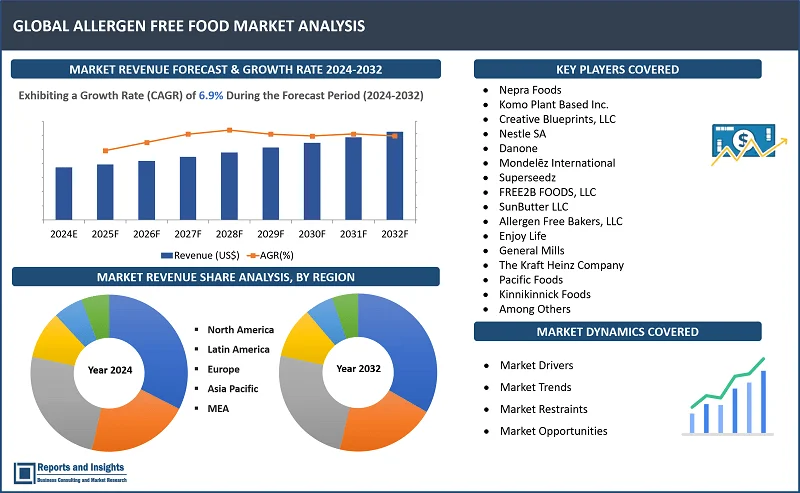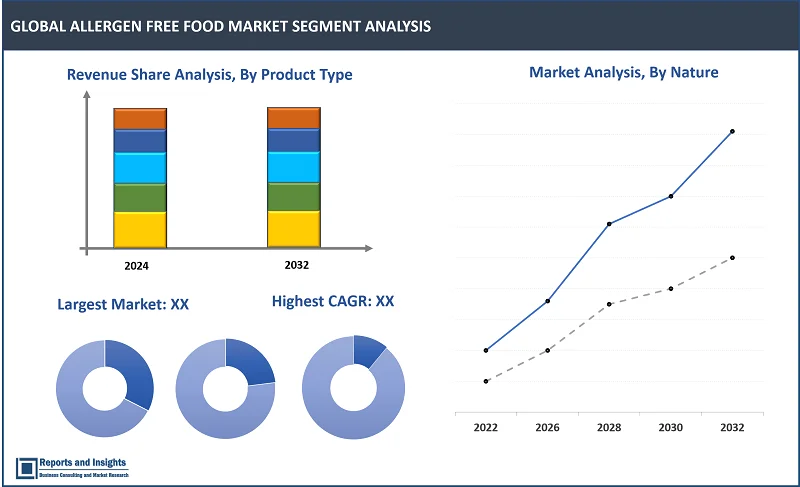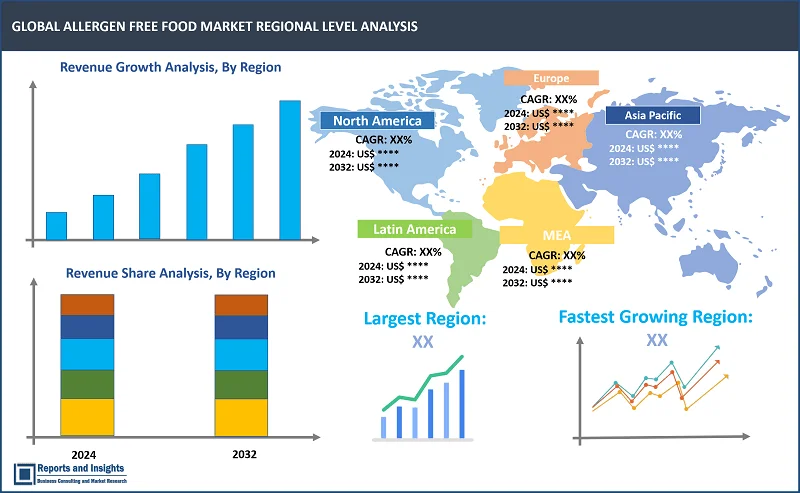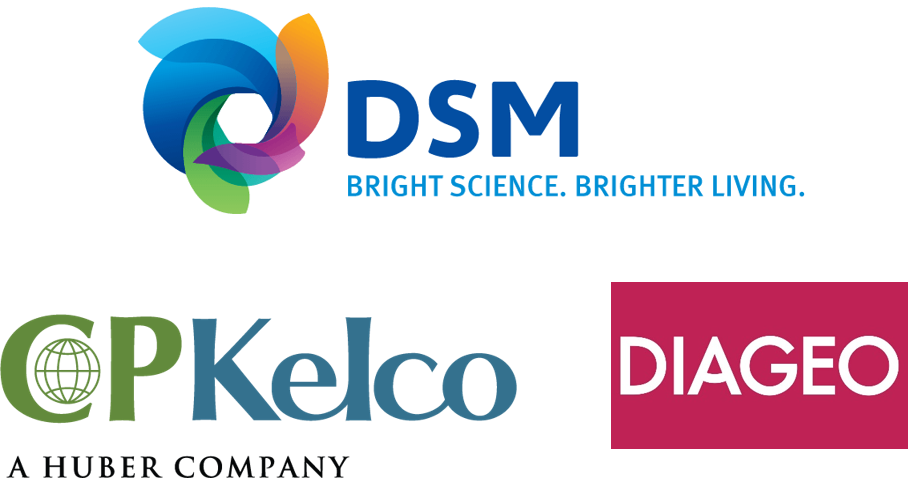Market Overview:
Reports & Insights predicts that the global allergen free food market is expected to grow at a CAGR of 6.9% during the forecast period from 2024 to 2032. Furthermore, the total value of the global allergen free food market is slated to reach US$ 116.7 Bn by 2032, rising from US$ 68.4 Bn in 2024.
|
Report Attributes |
Details |
|
Base Year |
2023 |
|
Forecast Years |
2024-2032 |
|
Historical Years |
2021-2023 |
|
Market Growth Rate (2024-2032) |
6.9% |
The market allergen-free food is expanding rapidly mainly due to the increasing prevalence among people with these conditions. The production process of allergen-free foods involves leaving out dairy products, eggs, soya beans and other legumes, peanuts, all kinds of nuts except peanuts, wheat flour, and seafood. An emergence of allergen free foods is transforming the food industry as it provides safe alternatives to multitude of allergic individuals worldwide. Also, this demand is not limited to people with allergies but extends to families and communities of these individuals thereby amplifying market growth. With increasing consumer awareness and diagnosis rates, there has been a surge in demand for allergen-free products.
In addition, key players are focused on developing allergen-free products such as allergen-free meals, snacks, drinks, and bakery items. Leading food manufacturers and start-ups are both investing in research and development to create healthy and tasty allergen free options that do not make any compromises on taste or quality. Another indication of this trend is the increase in allergen-free restaurants and cafes which target a growing population looking for safe eating places.
Further support for this movement towards allergen-free foods can be seen by regulatory agencies insistence on strict labelling and production requirements to safeguard consumers. Resultantly there is gaining acceptance in the market for these products which are free from allergens. The increasing availability of allergen-free food products and beverages in regular supermarkets as well as online outlets is giving consumers more opportunities to access safe food alternatives.
Overall, apart from addressing a critical health issue, the sector of allergen-free food is also an advocate for inclusivity and safety within global food markets. Therefore, as awareness spreads beyond demand, allergy friendly products will increasingly become part of people’s diet driving innovation across the entire spectrum of food production and consumption in future years.

Allergen Free Food Market Trends and Drivers:
The allergen-free food market is anticipated to experience significant growth attributing to several notable driving factors and trends. One of the most primary driving factor is rising prevalence of food allergies or intolerances among people worldwide and thus there is surge in demand of safe, allergen-free alternatives. According to the Centers for Disease Control and Prevention (CDC), food allergies are a growing food safety and public health concern that affects 6 % of adults and an estimated 8% of children in the United States. That's 1 in 13 children, or about 2 students per classroom.
Another reason behind the allergen-free food market growth is rising awareness about health issues related to allergens. Nowadays, consumers are well-aware of risks associated with certain types of food. Thus, the increased awareness affects an individuals’ purchases as well as creates opportunities in institutional sites like schools, hospitals, and workplaces which seek to offer safe and health food alternatives for all.
Furthermore, governments and regulatory bodies around the world impose stringent rules on food safety which also contribute to growing demand. The regulations on labeling of packaged foods that highlights their content aims at protecting consumers by warning them against products with allergic substances while promoting allergen-free goods. Compliance with these regulations enhances product credibility and consumer trust, boosting market adoption.
Allergen Free Food Market Restraining Factors:
The global allergen-containing foods market faces several restraining factors. High cost associated with allergen-free foods is one of the major challenges for the future market growth. These higher costs derive from the need for specialization, dedicated facilities to prevent cross contamination and stringent quality control measures. Also, the lack of availability and accessibility are also likely to hinder the market growth. Consumers’ skepticism about the taste and quality of allergen-free foods compared to traditional alternatives also contributes to the deceleration of market growth.
Allergen Free Food Market Opportunities:
The rapidly increasing consumer demand for safe and inclusive foods offers significant market opportunities to the global allergy-free food market. There is a sharp rise in food allergies and intolerances in people nowadays, giving food manufacturers a major opportunity to develop and expand their product range to create new and improved products with similar taste, texture and nutritional value as it is likely to appeal to a broad range of customers.
There is also potential for growth in emerging markets with increasing awareness and diagnosis of food allergies, resulting in new demand for allergen-free foods. Investing in research and development to discover new materials and improve processes can further improve product quality and reduce costs. Also, the growing trend towards clean eating and the demand for transparent labeling can support allergen-free foods as a preferable, health-conscious choice.
Allergen Free Food Market Segmentation:

By Product Type
- Gluten-Free
- Bread
- Pasta
- Snacks
- Cereals
- Dairy-Free
- Milk Alternatives
- Yogurt Alternatives
- Cheese Alternatives
- Others
- Nut-Free
- Baked Goods
- Snacks
- Confectionery
- Others
- Soy-Free
- Tofu Alternatives
- Snacks
- Beverages
- Others
- Egg-Free
- Mayonnaise Alternatives
- Baking Mixes
- Others
- Others
Dairy-free products dominate the global allergen-free foods market attributing to the increasing prevalence of lactose intolerance and dairy allergies globally. Also, the growing trend of veganism and plant-based diets further accelerates demand for dairy-free alternatives, making them the leading segment in the allergen-free food market.
By Nature
- Organic
- Conventional
The organic segment is expected to witness the fastest growth in the global allergen-free foods market owing to growing consumer preference for natural and clean-label products. Rising awareness about the health benefits of organic foods, coupled with rising environmental concerns, fuels demand for organic allergen-free options.
By Application
- Bakery and Confectionery
- Beverages
- Dairy Alternatives
- Snacks and RTE (Ready-to-Eat) Meals
- Infant Food
- Sauces, Dressings, and Condiments
- Others
The dairy alternatives segment is the most promising in the global allergen-free foods market because there is increasing prevalence of lactose intolerance and dairy allergies worldwide. Also, the rising trend of plant-based diets and veganism significantly boosts demand for dairy-free products, boosting growth in this segment.
By Sales Channel
- Supermarkets/Hypermarkets
- Convenience Stores
- Specialty Stores
- Online Retail
- Pharmacies/Drugstores
The Supermarkets/Hypermarkets segment dominates the global allergen-free foods market because these outlets offer a wide variety of products under one roof, providing convenience for consumers. Their extensive reach, regular foot traffic, and ability to showcase new products effectively drive higher sales of allergen-free foods in this segment.
By Region

North America
- United States
- Canada
Europe
- Germany
- United Kingdom
- France
- Italy
- Spain
- Russia
- Poland
- Benelux
- Nordic
- Rest of Europe
Asia Pacific
- China
- Japan
- India
- South Korea
- ASEAN
- Australia & New Zealand
- Rest of Asia Pacific
Latin America
- Brazil
- Mexico
- Argentina
Middle East & Africa
- Saudi Arabia
- South Africa
- United Arab Emirates
- Israel
- Rest of MEA
The global allergen free foodmarket is divided into five key regions: North America, Europe, Asia Pacific, Latin America, and the Middle East and Africa. North America dominates the global allergen-free foods market attributing to the high prevalence of food allergies and intolerances in the region. Additionally, advanced diagnostic facilities, strong consumer awareness, and stringent food safety regulations boost the demand for allergen-free products, facilitating market growth in North America.
Leading Companies in Allergen Free Food Market & Competitive Landscape:
The competitive landscape of the global allergen-free food market is characterized by key players adopting strategies such as product innovation, mergers and acquisitions, and extensive marketing campaigns. Companies are investing in research and development to create new and improved allergen-free products that cater to diverse dietary needs and preferences. Strategic partnerships and acquisitions enable these players to expand their product portfolios and market reach. Additionally, robust marketing efforts, including clear labeling and awareness campaigns, help build consumer trust and brand loyalty. These strategies collectively drive the growth and competitiveness of the allergen-free food market.
These companies include:
- Nepra Foods
- Komo Plant Based Inc.
- Creative Blueprints, LLC
- Nestle SA
- Danone
- Mondelēz International
- Superseedz
- FREE2B FOODS, LLC
- SunButter LLC
- Allergen Free Bakers, LLC
- Enjoy Life
- General Mills
- The Kraft Heinz Company
- Pacific Foods
- Kinnikinnick Foods
Recent Development:
-
April 2024, The Simply Good Foods Company, a developer, marketer and seller of branded nutritional foods and snacking products, and Only What You Need (“OWYN”), a leading plant-based, allergen-free ready-to-drink (“RTD”) protein shake brand, announced that the companies have entered into a definitive agreement under which Simply Good Foods will acquire OWYN for $280 million in cash. Only What You Need is the fastest growing RTD protein shake brand in the market and enhances Simply Good Foods’ portfolio with further diversification and provides the Company with a greater presence within the RTD protein shake segment.
Allergen Free Food Market Research Scope
|
Report Metric |
Report Details |
|
Allergen Free Food Market Size available for the years |
2021-2023 |
|
Base Year |
2023 |
|
Forecast Period |
2024-2032 |
|
Compound Annual Growth Rate (CAGR) |
6.9% |
|
Segment covered |
Product Type, nature, Application, and Sales Channel |
|
Regions Covered |
North America: The U.S. & Canada Latin America: Brazil, Mexico, Argentina, & Rest of Latin America Asia Pacific: China, India, Japan, Australia & New Zealand, ASEAN, & Rest of Asia Pacific Europe: Germany, The U.K., France, Spain, Italy, Russia, Poland, BENELUX, NORDIC, & Rest of Europe The Middle East & Africa: Saudi Arabia, United Arab Emirates, South Africa, Egypt, Israel, and Rest of MEA |
|
Fastest Growing Country in Europe |
UK |
|
Largest Market |
North America |
|
Key Players |
Nepra Foods, Komo Plant Based Inc., Creative Blueprints, LLC, Nestle SA, Danone, Mondelēz International, Superseedz, FREE2B FOODS, LLC, SunButter LLC, Allergen Free Bakers, LLC, Enjoy Life, General Mills, The Kraft Heinz Company, Pacific Foods, Kinnikinnick Foods, among others |
Frequently Asked Question
What is the market size of the allergen free food market in 2024?
The Allergen Free Food market size reached US$ 68.4 Billion in 2024.
At what CAGR will the allergen free food market expand?
The market is expected to register a 6.9% CAGR through 2024-2032.
Which is the fastest growing country in Europe ?
UK is the fastest growing country in Europe.
What are some key factors driving revenue growth of the allergen free food market?
Some key factors driving revenue growth are increasing prevalence of global food allergies and intolerances among consumers, rising awareness about allergen-related health issues, among others.
What are some major challenges faced by adopters of allergen free food solutions?
Some key challenges include high cost associated with allergen-free foods, stringent quality control measures and lack of availability and accessibility, among others.
How is the competitive landscape in the allergen free food market?
The competitive landscape of the market is characterized by key players adopting strategies such as product innovation, mergers and acquisitions, and extensive marketing campaigns. Companies are investing in research and development to create new and improved allergen-free products that cater to diverse dietary needs and preferences.
How is the allergen free food market segmented?
The market report is segmented based on by product type, nature, application, and sales channel.
Which top companies are included in the global allergen free food market report?
Top companies included in the report are Nepra Foods, Komo Plant Based Inc., Creative Blueprints, LLC, Nestle SA, Danone, Mondelēz International, Superseedz, FREE2B FOODS, LLC, SunButter LLC, Allergen Free Bakers, LLC, Enjoy Life, General Mills, The Kraft Heinz Company, Pacific Foods, Kinnikinnick Foods, among others

